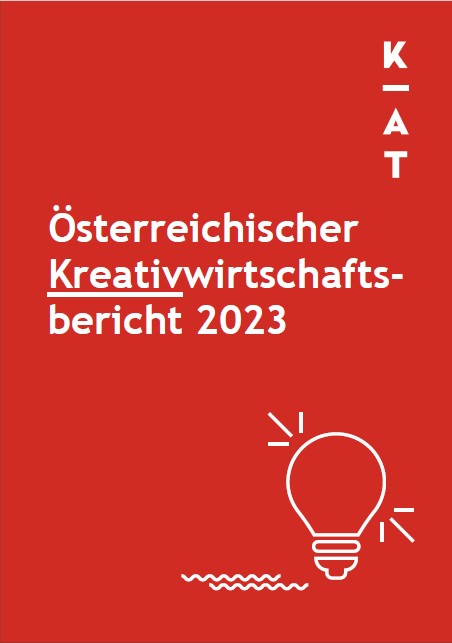Austrian Creative Industries Report 2023
The Creative Industries Report 2023 shows that the Austrian creative industries comprise around 50,000 companies with around 170,000 employees. The sector has made sales of EUR 24 billion, these have increased significantly by 13% from the first Corona year 2020 to 2022. Decisive factors for this are a continued positive development especially of the software sector, the recovery of the creative industries strongly affected by the Corona measures, such as the film and music industries, but also price increases.
At the start of the Corona crisis in 2020, the creative industries are experiencing declines compared to 2019
In 2020, around 11% of companies belonged to the creative industries, i.e. around 48,100 companies with 168,350 employees. Creative companies generate sales of around €24 billion and gross value added at factor cost of around €10.1 billion. After very successful years, the creative industries recorded declines with the onset of the Corona crisis in 2020. For example, the number of companies and employees fell compared with 2019, and there were also declines in sales and gross value added, although these were somewhat smaller than in the economy as a whole. In a long-term comparison (2008 to 2020), the creative industries have developed more dynamically than the overall economy.
Revenues of creative industries companies increased significantly in the period 2020 to 2022
After experiencing year-on-year declines in 2019/20, companies in the creative industries recorded nominal revenue increases in 2021 and 2022. The increase was slightly higher in 2021 (compared to 2020) (+7%) than in 2022 (compared to 2021; +6%). Thus, revenues in the creative industries in 2022 were 13% higher than in 2020. This positive development is strongly supported by the software sector; in addition, areas with high revenue declines at the beginning of the Corona crisis, such as the film and music industries, have been able to recover. Price increases are also playing a role.
In 2022, 10% more employees* are employed in creative industries companies than in 2020
Compared to 2020, the situation on the labor market has improved significantly. Overall, there are 10% more employees in creative industries companies in 2022 than in 2020, with the highest growth in the software and games sector (+16%). Only in the music industry is a decline of 2% observed, whereby the minus in the first Corona year 2020/21 (-3%) could not yet be compensated for in 2022 (+1%).
Unemployment in 2022 is 33% lower than in 2020
After a sharp increase between 2019 and 2020, the number of unemployed people formerly working in the creative industries fell again significantly in 2021 and 2022. Over the entire period (2020 to 2022), this represents a decline of 33%. The most significant decline was recorded in the smaller areas of design and radio and TV.
The largest creative industries continue to be software and games, advertising, performing arts market, books and publishing, and architecture
In terms of employment, sales and gross value added, software and games, advertising, the performing arts market, books and publishing, and architecture are among the top 5 creative industries. In contrast, radio and TV, the music industry and design are among the smaller sectors. While the software and games as well as radio and TV sectors developed dynamically between 2019 and 2020, the performing arts market and film industry (incl. photography) saw significant declines.
Above-average equity ratio in the creative sectors of books and publishing as well as design, high profitability in architecture as well as software and games
The book and publishing and design sectors have the highest equity ratio in comparison, averaging around 39 %. However, all other creative sectors also have a satisfactory average equity ratio above the recommended minimum of 30%. Architecture and software and games, for example, achieve above-average return on sales, while advertising, design and the film industry, including photography, have below-average profitability.
63% of creative businesses are one-person businesses
Another characteristic of the creative industries is their small-scale structure. Sixty-three percent of the companies are one-person enterprises (EPUs). An above-average number of EPUs can be found in the performing arts market (81 %), in the film industry (76 %) and design (73 %), in the music industry (66 %) and in advertising (65 %).
More than one in four companies in the creative industries is run by a woman
More than one in four companies (26%) is run by a woman, with an above-average proportion in the book and publishing, performing arts market, and
design. In the software and games, music, radio and TV, and architecture sectors, on the other hand, the proportion of female self-employed is below average.
39% of creative companies are headquartered in Vienna, 61% are located outside of Vienna
39 % of creative enterprises are located in Vienna, 61 % in the other Austrian provinces. A large number of creative enterprises can be found in Lower Austria (14 %), Upper Austria (11 %) and Styria (11 %). In Vienna, almost every fifth company belongs to the creative industries. Architecture has an above-average presence in Vorarlberg and Tyrol, and advertising in Salzburg.
Developments in start-ups in the creative industries continue to vary widely
The largest number of startups in 2022 will continue to be in the field of information technology (incl. management consulting and accounting), with around 3,000 startups, up 1% on the previous year. This is followed by the specialist groups advertising and market communication with 2,400 start-ups (-5%) and arts and crafts with around 1,000 start-ups (-3%).
The Austrian Creative Industries Report is published by Kreativwirtschaft Austria of the Austrian Federal Economic Chamber as part of the Creative Industries Strategy of the Federal Ministry of Labor and Economic Affairs.
